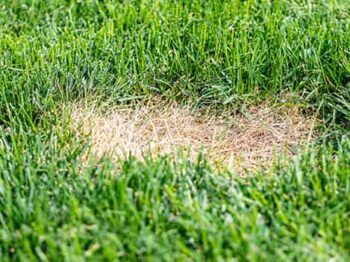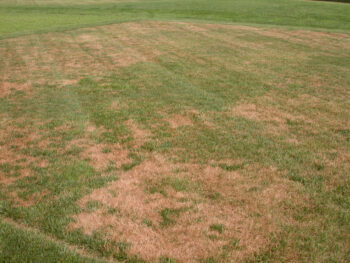BROWN PATCH
Rhizoctonia Blight or the more commonly known name Brown Patch disease is a hot weather disease that can occur on all types of turf. However it is most damaging to tall fescue, perennial ryegrass, creeping bentgrass and annual bluegrass. Kentucky bluegrass, Zoysiagrass and other species of grass can be occasionally injured and southern grasses tend to see injury later in the fall than the summer. Brown Patch often first appears as rough circular patches varying roughly in size from 1-5 feet in size. In the early morning dew, fine strands of grayish cobwebby fungal growth may be evident called mycelium. This quickly disappears as the dew dries. Individual leaves on the turf die back from the tip and can turn dark green then yellow as they wither and decay.
CONDITIONS FAVORING THE DISEASE
Brown Patch is caused by infection of grass foliage and crowns by Rhizoctonia fungi. Rhizoctonia fungi often harmlessly colonize organic matter into thatch, however during times of stressful conditions Rhizoctonia can infect plants and cause disease. The conditions that favor Brown Patch development in cool season grasses are when temperatures are above 85F and high relative humidity. A minimum temperature of 61F in combination with evening showers or night time watering or relative humidity above 95% for more than 8 hours increases the chances of brown patch. In warm season grasses injury due to brown patch is most severe in humid weather with moderate temperatures (45-70 F).
MANAGEMENT
Rhizoctonia fungi will flourish during hot humid weather. Over watering, watering in the late afternoon, poor soil drainage, lack of air movement, thatch build up and shade on your lawn can create a favorable environment for Brown Patch. Mowing your lawn late in the evening, when the lawn is wet, or with a dull mower blade that frays the top of the leaf will also contribute to the severity of Brown Patch. Remember to keep your mower blade razor sharp and follow our Mowing and Watering tips to help avoid Brown Patch.


